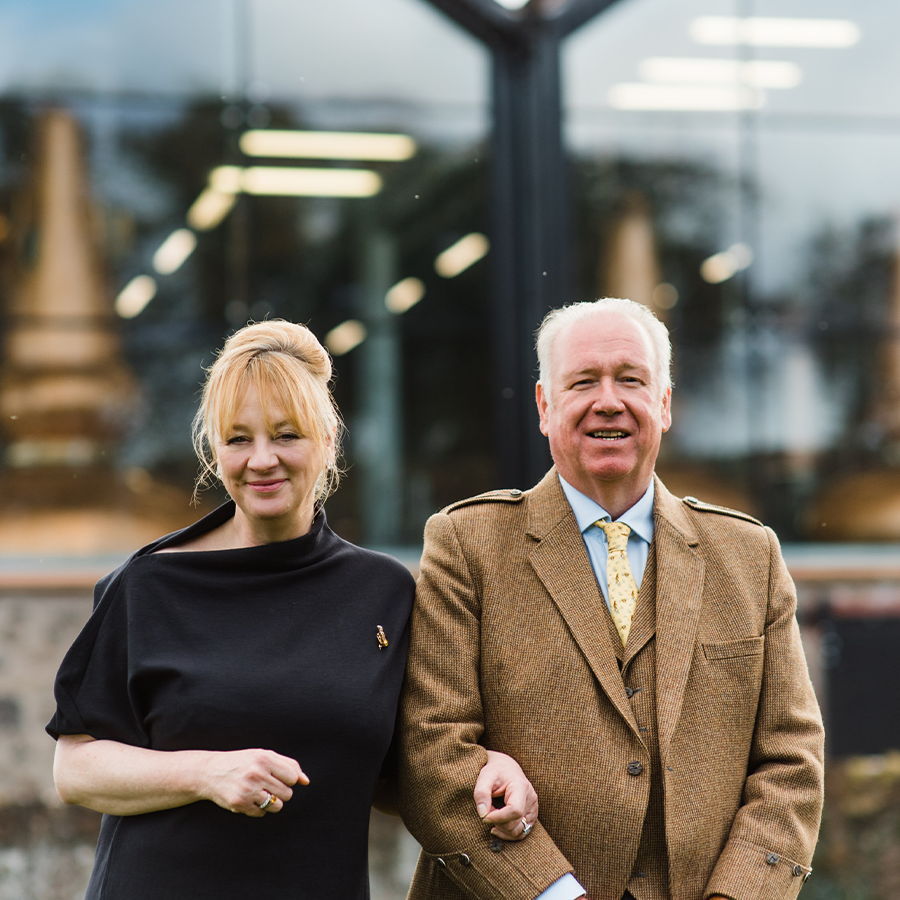A journey through time at Lindores Abbey
Author: Issariya Morgan

Lindores Abbey is a Scottish distillery with a history dating back to 1494. We speak to founder Drew McKenzie Smith about its rich heritage and shaping the next chapter in a long story.
On the banks of the River Tay, not too far from the village of Lindores, there is an abbey, which has stood in the same place since the 12th century. Throughout the centuries, the “Church by the Water” has passed through the hands of various generations of monks.
Today’s custodians are not monks, but husband-and-wife team Drew and Helen McKenzie Smith. The couple head up a team that now produce two spirits on the site of the medieval abbey: a single malt Scotch whisky and Aqua Vitae, a botanical spirit.
It’s a fascinating story to step into – but how did they come to inherit such a legacy?
“The abbey sits on a farm in Fife, which had been in my family for over 100 years,” Drew tells me over our Zoom call. “We were blissfully unaware of its history. It’s nice to have a ruined abbey in your back garden – but that’s what it was.
“We used to keep horses and cattle there, and I used to ride motorbikes around. Looking back, I probably didn’t respect it as much as I should have,” he laughs.
A stranger arrives
Then, one day in the late 1990s, there was a knock on the door. “I wasn’t there at the time, but my father was there,” Drew recalls. “A chap turned up at our door and asked if he could wander around the abbey. Dad was slightly bemused because not many people had done that before, but he said, ‘sure, knock yourself out’.
“The chap went in, looked around and left without really saying anything. Dad forgot about it. Then, six or seven months later, this lovely hardback book arrived called Scotland and its whiskies. It was written by the late Michael Jackson, who was arguably the leading whisky and beer writer of his day. It just said: ‘To Ken, many thanks. Turn to page 170’. Dad did just that, and there was a lovely picture of the abbey. The chapter starts: ‘For the whisky-lover, it is a pilgrimage.’”
For Drew’s family, that was the first time they became aware that the ruined abbey in their back garden had a special significance – one of particular importance in the whisky world. “I thought: it’s nuts to have this in your garden and not try to do something with it.”
And so, a story that began in the 12th century reached an important new chapter at the turn of the millennium. Once the seed had been sowed, Drew and Helen slowly started moving from their previous profession – “looking after huge castles for exclusive use” – towards building a distillery on the grounds of the old abbey.
Unearthing the past
The Lindores Abbey distillery was built in early 2016. Their first spirit was produced in December 2017, and that spirit became their first whisky in December 2020.
With the distillery built so close to the abbey, the team always had to have an archaeologist with them. Were there any major discoveries unearthed in the process?
“We were building one day, digging the grounds up with the JCB,” recounts Drew. “Then Rebecca, our archaeologist, came running over saying, ‘Stop the JCB.’ We found what we all thought was a medieval well: a circle of stones with water inside. But then, Rebecca very carefully started taking the water out of it to find it was a clay bowl. Everyone was scratching their heads, wondering what it could have been. Long story short, it turned out to be a base where a still would have sat.”
Subsequently, the team tested the site to uncover what it could have been used for, and found traces of wood, carbon and barley. “Now, we can confidently say what it is. It was mind-blowingly exciting.”
1494 appears to be a significant year in the abbey’s history. Drew tells me this is because it was the year that a monk called Friar John Cor was commissioned by the king to make aqua vitae.
“I’ve got a huge debt of gratitude to the historian that found this,” he says. “There’s a scroll, which is around 30 yards long, called the Exchequer Roll: the king’s tax record of 1494. It’s written in Latin. Buried deep in the middle of it – and even when you’ve been shown where it is, it’s hard to locate – there’s a little line that reads: ‘Friar John Cor, eight bowls of malt, wherewith to make aqua vitae for the king.’
“I’m very open to the idea that distilling happened before that, but that’s the earliest written reference to what is now Scotch whisky. ‘Aqua vitae’ became uisce beatha, which became ‘whisky’.”
From past to present
Inevitably, this rich history has played a formative part in shaping the distillery’s philosophy.
“We’re very proud of our history, and it’s a huge part of what we do,” says Drew. “But to pay due respect to that history, the spirit we produce here has to match the legacy – otherwise we’re selling our history cheaply.
“My bank manager probably still shudders,” he laughs, “but from the start, I said I’d find the money to build the best distillery and produce a spirit that matches it.”
It’s clear that Drew sees this current generation of custodians as simply the latest in a long line, with a responsibility to pass it onto the next generation.
“This is an intergenerational project,” he says. “In my opinion, they’re the best kind.”
Browse spirits from Lindores Abbey here.



I love this story, and never tire of telling it in my role as part-time tour guide. It’s a wonderful place to work and I’m very proud to be part of the team.